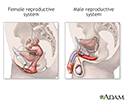Gender dysphoria
Transsexualism; Transgender
Gender dysphoria occurs when there is a conflict between a person's physical gender and the gender he or she identifies with. For example, a person who is physically a boy may actually feel and act like a girl. The person is very uncomfortable with the gender they were born as.
Causes
Gender dysphoria used to be known as gender identity disorder.
People with gender dysphoria may act as members of the opposite sex. Gender dysphoria may affecta person's:
- Choice of sexual partners
- Mannerisms, behavior, and dress
- Self-concept
Gender dysphoria is not the same as homosexuality.
Identity conflicts need to continue over time to be considered gender dysphoria. How the gender conflict occurs is different in each person. For example, some people may cross-dress while others want sex-change surgery. Some people of one gender privately identify more with the other gender.
People who are born with ambiguous genitalia , which can raise questions about their gender, may develop gender dysphoria.
Ambiguous genitalia
Ambiguous genitalia is a birth defect where the outer genitals do not have the typical appearance of either a boy or a girl.

The cause of gender dysphoria is unknown. Hormones in the womb, genes, social and environmental factors (such as parenting) may be involved.
Symptoms
Symptoms can vary by age and are affected by the person's social environment.
Children may:
- Be disgusted by their own genitals
- Be rejected by their peers, feel alone
- Believe that they will grow up to become the opposite sex
- Say that they want to be the opposite sex
Adults may:
- Dress like the opposite sex
- Feel alone
- Want to live as a person of the opposite sex
- Wish to be rid of their own genitals
Adults and children may:
- Cross-dress, show habits typical of the opposite sex
-
Have
depression
or
anxiety
Depression
Depression may be described as feeling sad, blue, unhappy, miserable, or down in the dumps. Most of us feel this way at one time or another for shor...
 ImageRead Article Now Book Mark Article
ImageRead Article Now Book Mark ArticleAnxiety
Stress is a feeling of emotional or physical tension. It can come from any event or thought that makes you feel frustrated, angry, or nervous. Stres...
 ImageRead Article Now Book Mark Article
ImageRead Article Now Book Mark Article - Withdraw from social interaction
Exams and Tests
The feeling of being in the body of the "wrong" gender must last for at least 2 years for this diagnosis to be made. A history and psychiatric evaluation can confirm the person's constant desire to be the opposite sex.
Treatment
Individual and family therapy is recommended for children to create a supportive environment at home and in school. Individual and, if appropriate, couples therapy is recommended for adults.
Sex reassignment through surgery and hormonal therapy is an option. But identity problems may continue after this treatment.
Outlook (Prognosis)
Diagnosing and treating gender dysphoria early can reduce the chance of depression, emotional distress, and suicide.
When to Contact a Medical Professional
Make an appointment with your health care provider if you or your child has symptoms of gender dysphoria.
References
Adelson SL; American Academy of Child and Adolescent Psychiatry Committee on Quality Issues. Practice parameter on gay, lesbian, or bisexual sexual orientation, gender nonconformity, and gender discordance in children and adolescents. J Am Acad Child Adolesc . 2012;51:957-974. PMID: 22917211 www.ncbi.nlm.nih.gov/pubmed/22917211 .
American Psychiatric Association. Diagnostic and Statistical Manual of Mental Disorders . 5th ed. Arlington, VA: American Psychiatric Publishing. 2013.
Shafer LC. Sexual disorders and sexual dysfunction. In: Stern TA, Fava M, Wilens TE, Rosenbaum JF, eds. Massachusetts General Hospital Comprehensive Clinical Psychiatry . 2nd ed. Philadelphia, PA: Elsevier; 2016:chap 36.
White PC. Disorders of sexual development. In: Goldman L, Schafer AI, eds. Goldman's Cecil Medicine . 25th ed. Philadelphia, PA: Elsevier Saunders; 2016:chap 233.
-
Male and female reproductive systems - illustration
The male and female reproductive systems, viewed from a mid-sagittal section.
Male and female reproductive systems
illustration
Review Date: 2/21/2016
Reviewed By: Timothy Rogge, MD, Medical Director, Family Medical Psychiatry Center, Kirkland, WA. Also reviewed by David Zieve, MD, MHA, Isla Ogilvie, PhD, and the A.D.A.M. Editorial team. Editorial update 08/15/2016.

